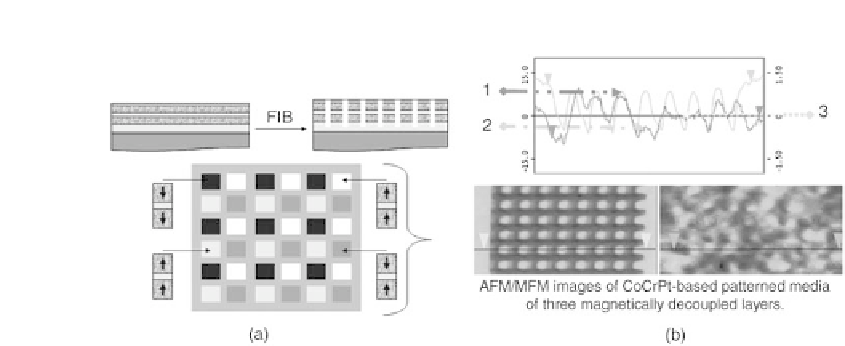Information Technology Reference
In-Depth Information
Figure
6.7.
(a) A schematic illustrating a two-layer 3D media. (b) A MFM image
of a patch on the surface of FIB-fabricated CoCrPt-based two-layer 3D media.
A digitized sectional profile of the signal along the highlighted line is shown
above the AFM/MFM images.
6.2.5. Design of a New Multilevel Magnetic System
The general task is maximizing the number of signal levels while maintaining SNR
between the signal values in each pair of adjacent levels above approximately 5 dB.
The 5 dB value is dictated by the requirements of the novel data encoding
methods, as described below.
The magnetic system probably would be further modified and optimized with
the goal to maximize the number of ''distinguishable'' signal levels.
6.2.5.1. Modification of a Magnetic System.
As mentioned earlier, it is
assumed that the material science underlying the new media type has been studied
in the prior related work. To formulate the approach in one expression, it is
necessary to develop media in which each magnetic grain could be recorded
independently (without a chain clustering effect). In fact, a conventional CoCr-
based composition (as used in conventional longitudinal recording media) could
be used for this purpose, and the media could be made even thicker to fully
maximize the effective number of individual Co grains participating in the process.
The focus of this chapter is directed towards engineering a new system to address
the above described requirements on multilevel recording. In other words, the
chapter is aimed at designing a system with substantially increased recording and
sensitivity fields (used for writing and reading information, respectively), thus
enabling adequate SNR to accommodate as many signal levels as possible, with
5 dB difference between any two adjacent levels. The data encoding methods
proposed in the chapter are aimed at providing sufficient bit error rates for
maintaining SNR of the order of 5 dB.






Search WWH ::

Custom Search